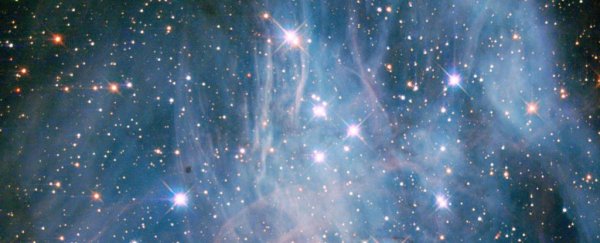The most massive stars in the Universe are also the shortest-lived. The more mass a star has, the more quickly it burns through its fuel reserves, resulting in lifespans that are less than around 10 million years.
This fascinating fact leads us to a puzzle. Most of these stars are found relatively close to the regions where they were born. But a number of them have been found lurking in strange pockets of the Milky Way, far from the galactic disk where star formation takes place; in other words, their birthplaces.
So far, in fact, that the travel time it would have taken to get there vastly exceeds the lifespans of several of the stars.
"Astronomers are finding massive stars far away from their place of origin, so far, in fact, that it takes longer than the star's lifetime to get there," said astronomer Douglas Gies of Georgia State University. "How this could happen is a topic of active debate among scientists."
This absolute dilly of a cosmic pickle, having long perplexed astronomers, may now have an explanation thanks to new research.
The focus of the study was a star named HD 93521. This is an O-type star, the most massive category of stars on the main sequence. HD 93521 is also about 3,600 light-years from the galactic disk, sitting in a sparsely populated region called the galactic halo. That's quite a distance, so Gies and his colleagues wanted to find out if there's a reasonable way it could have gotten there.
They used data from the European Space Agency's Gaia satellite. This is an ongoing project to map the Milky Way with the highest precision possible, in three dimensions and including data on the motions and velocities of the stars. They also carefully analyzed the spectrum of light the star is emitting, to help determine its mass, age, and spin.
The Gaia data revealed that HD 93521 is about 4,064 light-years from Earth and the aforementioned 3,600 light-years from the galactic disk.
The team also calculated that the star is about 17 times the mass of the Sun, with an average temperature of roughly 30,000 Kelvin. At that mass and temperature, the star should be around 5 million years old, with a margin for error of about 2 million years. Its maximum lifespan is approximately 8.3 million years.
To migrate from its birthplace in the galactic disk to its current position, however, would take a journey of roughly 39 million years.
This is a real head-scratcher, but the star itself could hold the key to the mystery. Our Sun's rotation rate is just under 2 kilometers (1.24 miles) per second. HD 93521 rotates at an absolute breakneck velocity of 435 kilometers (270 miles) per second.
There are several mechanisms that can increase the rotation speed of a star. One of the biggest effects would be through a stellar merger, which would combine not just the spins of the two stars, but also the angular momentum of their orbit.
This is what the team thinks happened with HD 93521. It started its life as a binary consisting of two middling-mass stars, which merged together to form the star as we see it today in the relatively recent past.
These middling-mass stars would have long enough lifespans to survive the journey into the galactic halo, the researchers said.
They've even found a binary that could validate their finding. Another star system IT Librae is a binary consisting of two B-type stars (a step smaller than O-type stars), one of which is more massive than the other.
That larger star, too, seems to be too short-lived for the travel time it would have taken to reach its current position. But in a paper currently in press, a team of researchers explains that the two stars are in a close binary, and the smaller one has already started transferring mass to the larger.
That means that the larger one's current mass is deceptive; because it started out smaller, its lifespan is likely longer than it currently appears.
"The observed properties of HD 93521 all appear to agree with expectations for a merger product. The star appears to be too young compared to its time of flight from the Galactic disk because it was rejuvenated through the stellar merger of the binary components," the researchers wrote.
"Investigations of such systems will provide important clues about the properties of post-mass-transfer and merger systems that are key to understanding their final supernova progeny."
The research has been published in The Astronomical Journal.
